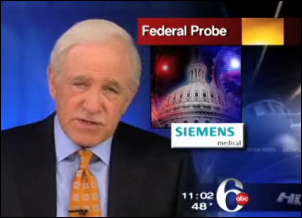"A valid concern..." Oh please. Everyone picks the software they like and the origin of that software is an afterthought.…
News 4/24/09
From Harry Reems: “Re: EHR certification. Do hospitals using an internally developed EHR have to get CCHIT or someone else to certify it to be eligible for HITECH incentives?” I’ll throw out a guess of “yes” given the inordinate confidence placed in CCHIT so far to decide whether a given product is one taxpayers should help pay for, but surely someone knows more than me.
From Eldridge Dickey: “Re: Dubai. I’m curious how bad things have gotten there after all the healthcare IT activity last year. Not much reporting in the mainstream news.” Ms. Adventure provided a bleak assessment in February, but has not sent updates since. First-person reports are welcome.
From The PACS Designer: “Re: VA private cloud. InformationWeek reports that the move to create ‘private clouds’ as a test bed for a cloud computing platform is gaining momentum among the advanced IT developers. Even the VA has started to experiment with a private cloud called ‘Health Associated Infection and Influenza Surveillance System’.” Link.
An update on the federal raid at Siemens Medical Solutions in Malvern, PA. Nobody’s saying officially what the feds were looking for, but rumors are that it could relate to an earlier whistleblower lawsuit claiming that Siemens did not give the government its lowest prices. That would align with who did the raiding: the criminal unit of the Defense Department. It may be connected to the $267 million contract the company won just three weeks ago to sell imaging equipment to the DoD. There’s a lot at stake since supplier fraud falls under the Federal False Claims Act (aka qui tam), which calls for damages equal to three times the overcharge plus up to $11,000 for each individual “false payment demand,” meaning each bill, invoice, contract, etc. Every one of the biggest judgments and settlements under that act involved healthcare: Tenet ($900 million), HCA ($731 million), HCA again ($631 million), HealthSouth ($325 millon), and a slew of drug companies and miscellaneous specialty care organizations. Siemens has previously admitted and paid billions in damages for bribery, falling under the US Foreign Corrupt Practices Act since it’s a German firm. Interestingly, Siemens may have paid those big fines because the alternative was being banned from bidding on government contracts (the CEO of the company’s US subsidiary was reported to have said that he expects the company to get $75 billion of the $787 billion in federal stimulus money). All of that is unverified speculation, although I’m a pretty good speculator.
Listening: Garageland, defunct Pixies-like New Zealand indie pop.
Jobs: Meditech Financial/Billing Expert, McKesson Analysts, Senior Cisco Wireless Expert.
Housekeeping: if you want to get HIStalk before your competitors and co-workers, put your e-mail address in the Subscribe to Updates box in the upper right corner of the page (you should have seen the server load when I sent out the Siemens raid story, which thanks to a reader tip, went out here long before any of the industry press found it, probably by reading their own HIStalk e-mail update). The search box in the right column will dig through almost six years of HIStalk to find your name, your company’s name, or whatever industry term you like. HIStalk’s sponsors are an important part of the mix, so peruse their ads and check out what interests you (I need to thank Founding Sponsors Medicity and Nuance since I haven’t done that recently). And if you want to send me a rumor or something I’d find interesting, click the ugly green Rumor Report box to do that easily. Thanks for reading, by the way.
I get quite a few e-mails listing things individual readers love or hate about HIStalk (almost always the same things, just with opposing opinions). The best way to register your opinion is by completing my short, once-a-year reader survey. I’m not going to beige HIStalk down by turning it into a committee-run snoozefest that everybody tolerates but nobody loves since we’ve got plenty of industry choices for that, but I do reconsider my direction each year when the survey runs (it’s pretty much the same survey I’ve been using for years). Some are great ideas that are a bit lofty for a day-job guy, like undertaking major investigative reporting, convincing hospitals to provide detailed success stories, etc. (kind of amusing since people who work no more day job hours than me complain that it takes 10 minutes to read – it takes me FOUR HOURS to write it after I get home plus Inga’s time, so playing Woodward and Bernstein is probably not in the cards). Anyway, I promise to read and consider every survey response.
CPSI’s Q1 numbers: revenue up 2.1%, EPS $0.37 vs $0.32.
Hospital layoffs: Ministry Health Care (WI), 60 employees; Shriner’s (HI), 10.
The 21 horses that died during a Florida polo match suffered a medication error when a compounding pharmacy incorrectly prepared a vitamin product.
The King of Pork, Senator John Murtha of Pennsylvania, brings home the bacon to fund a desolate, barely used (three flights a day) airport bearing his name in the middle of Nowhere, PA: $200 million in earmarks for what watchdogs call a “museum piece” with fewer than 10,000 passengers a year (its only flights go to Washington Dulles) that will get a second runway, joining the $8 million air traffic system installed in 2004 that has never been used because there are no employees to run it. His Military Interoperable Digital Hospital Testbed, also in Johnstown, got $5 million of Murtha Money, which one might at least hope has something to do with the DoD-VA interoperability projects going on instead of just paying Northrop Grumman contractors to fly back and forth from DC on the taxpayer time (that’s probably the three flights a day).
Microsoft’s Q3 report: revenue down 6%, EPS $0.33 vs. $0.47, the first time the company’s quarterly revenue has ever decreased. Announced: no employee merit increases this year, no earnings guidance will be provided, and the upcoming quarter isn’t looking any better than the last one.
Healthcare Growth Partners releases its Q1 HIT transaction report (free PDF download). An interesting observation about recent M&A transactions: they involved either premium deals or fire sales.
One HIStalk reader always finds and sends bizarre healthcare news items, so here’s his latest. A male nurse whose former job was a stripper is suing his personal care home employer for sexual harassment, claiming he was propositioned, called a “pretty boy”, asked for lap dances and to provide bachelorette party performances, was slapped and pinched in the rear, and was referred to by elderly residents as “one of them go-go boys” and a “hootchie-kootchie dancer.” He claims he was fired because he’s a 55-year-old man who was not taken seriously by the mostly female nursing staff.
I’ve let Inga gradually do more of the research and writing for HIStalk Practice, so she posted solo last night while I attended to pressing day job duties. She’s cute and 1000 ccs of fun, but insecure: she e-mailed me almost immediately afterward to say, “I’m dying … was it OK?” Isn’t that adorable? I think she craves validation, so if you want to suck up shamelessly, she would probably be your immediate BFF.
Kryptiq sells its Choreo health plan contracting division to health plan software vendor Portico Systems to focus on its Connect IQ medical communications network.
Free Australian PHR vendor miVitals goes belly up for lack of funding because it has no partnerships like its big-name competitors, according to the Washington Post. With all the interest in PHRs (misplaced, I think), you would think its assets would be worth something. Perhaps this is the first of a wave of dot-com like PHR failures given that most of them don’t charge anything, usage is low, value is questionable even for free, and the big boys are using their clout. If you think doctors don’t like using technology that doesn’t fit their routine, try getting the average patient to do so.
HERtalk by Inga
From John Moore: "Re: Health 2.0 conference. Health 2.0 remains an event that has a lot of cheerleaders, groupies, and technologists and unfortunately, not enough consumers/patient stories in how they are actually using all of these new Health 2.0 solutions coming into the market. The Health 2.0 companies who present don’t help their cause either, as virtually none of them presented any meaningful stats on consumer or clinician adoption and use of their technologies. That being said, there were some highlights including John Halamka, BIDMC and Roni Zeiger of Google Health talking through the problems of administrative data being exported out of a hospital to a consumer’s PHR, e.g., e-Patient Dave. Also, John Wennberg, lead author of the Dartmouth Atlas, gave a great presentation, best of show really, with real numbers about what is and is not working and some of the hard choices that need to be made, e.g., too much acute care today/wasted money spent at end of life – need to redirect those resources to community health initiatives."
Have an opinion on the how to define "meaningful use" in the HIT world? The National Committee on Vital and Health Statistics executive subcommittee schedules a gathering April 28-29 in Washington to figure it all out. The public is welcome and we’ve embedded a mole in the proceedings who will give us an update.
Ingenious Med, a provider of billing tools for inpatient physicians, raises $1 million in VC money to beef up its sales and marketing efforts.
West Penn Allegheny Health System files a complaint in US District against regional rival UPMC and Highmark, alleging conspiracy to protect one another from competition.West Allegheny’s chairman says, "We believe that for several years UPMC and Highmark have engaged in mutual back-scratching designed to preserve Highmark’s monopoly in health insurance and to permit UPMC to build a monopoly." The financially troubled West Penn Allegheny announced operating losses of $9.1 million for the quarter ending December 31, leading UPMC to issue a statement calling the lawsuit frivolous and a "tactic to divert attention from their own operating and financial difficulties." Can’t we all just get along?
Bate County Medical Hospital (MO) selects the web-based OpusClinicalSuite EMR for its 60-bed hospital.
Shameless plug: if you are not reading our new HIStalkPractice site, you are missing out. This week we had two excellent columns that are definitely worth a read. Dr. Gregg Alexander’s piece entitled, "Two Thirds of the NHIN by 2010 (or, Not Your Daddy’s CHIN)" is thoughtful, humorous, and well-written. Dr. Joel Diamond writes on the need to expand the use of natural language processing in EMRs, and throws in some hilariously immature humor in the process. We are also posting news and commentary twice a week on topics of particular interest to those in the ambulatory care space. Check it out and sign up for e-mail updates so you can keep up with all the cool happenings.
HIStalk sponsor MEDSEEK is hosting a free webinar April 29th discussing the patient-centered medical home and why it should be important to hospital executives. Here’s the link to sign up or learn more.
Valley Baptist Health System (TX) decides to outsource its IT services to PHNS and help the hospital complete its EHR implementation. The 10-year agreement allows Valley Baptist’s employees to remain as employees, but will be managed by PHNS.
An apparently confused city treasurer in Albany, NY sites potential HIPAA violations as the reason she cannot release copies of forgiven parking violations to city council leaders. Council members call the explanation "absurd."
Three ER docs and a computer guy rock Delaware in a band called Code Blue. Sounds like the perfect BFFs for Mr. H.
Gwinnett Medical Center (GA) contracts with InfoLogix to provide a wireless infrastructure assessment, followed by the development of a a customized mobile deployment strategy.
Random musing: the last couple of days I have followed Twitter, particularly noting the messages about the Health 2.0 seminar. At least half a dozen Twitterers were sending updates on virtually every word being said by the speakers. While at times interesting, I had to finally step back and ask myself if all these tweets were really adding value. I wanted to know what’s going on in the forest rather hear about every last tree. Am I the only one who feels that way? I’ve never been a huge fan of webinars or podcasts, probably for the same reason. In the past, I’ve worried if the problem is that I lack sufficient curiosity, but now I’m thinking the real issue is information overload.
Emergency room visits are up while the number of emergency departments are falling, according to a new Picis-sponsored study. As a result, patient satisfaction and ED performance have fallen over the last 10 years. The details are included in the final report, "Profiling Success: Managing Emergency Services in the Largest Health Systems,” which includes specifics on best practices from top performing hospitals.
St. Joseph’s Healthcare System (NJ) plans to implement the INFINITT Enterprise-wide PACS solution.







Harry Reems –
As with most things in HITECH there is flexibility for HHS interpretation but here is the relevant text:
“The eligible hospital demonstrates to the satisfaction of the Secretary, in accordance with subparagraph (C)(i), that during such period the hospital is using certified EHR technology in a meaningful manner.”
Note that nowhere in ARRA legislation is it stated that certified EHR equates to CCHIT, though CCHIT and HIMSS sure are talking as if it is a done deal. Expect a grandfather clause of sorts for those who have already adopted a CCHIT-certified EMR. As for RYO solutions, remains to be seen exactly how these will be “certified” and HHS, with NIST’s assistance could pursue a number of different and less burdensome means of certification that meet the letter & objectives of the legislation without CCHIT’s burdensome process.
NHIN 2010: “Some men see things as they are and say why – I dream things that never were and say why not.”
Maybe Shaw was on to something?
Yes, the door has been left open for CCHIT to have a continuing role. However, in my opinion, there are some things the private sector cannot accomplish efficiently, and a meaningful set of EHR certification standards is one of them.
I think the fed need to take the bull by the horns and dictate what the standards will be. And, the sooner the better.
Twitters that perpetually tweet are twits. Tweets from Twits are nothing more than cerebral turds. – Confucius (yea, right)